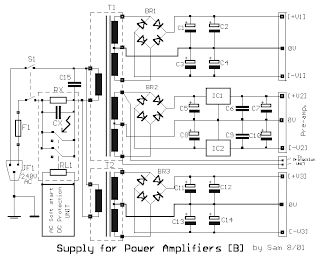The objective of the circuit is to create a power supply using V-MOSFET technology to support amplifiers while producing 100 Watts power output.
Terminology
- Vertical Metal Oxide Semiconductor Field Effect Transistor (V-MOSFET) – a type of power MOSFET used for several applications where the requirements are medium powers and has an arranged structure with a V-groove
- 7812 – 3-terminal 1A positive voltage regulator with short circuit protection, thermal overload protection, output transistor safe operating area protection, output current up to 1A, and output voltages from 5V to 24V
- 7912 – a 3-terminal negative voltage regulator with several fixed voltages which makes it useful in a wide range of applications like split power supplies and can provide local on-card regulation, eliminating the distribution problems associated with single point regulation, can deliver over 1.5A output current if sufficient heat sinking is provided and obtain adjustable voltages and currents if used with external components
- Bridge Diode – also known as bridge rectifier which has four diodes arranged in a bridge configuration where the output voltage has the same polarity with either polarity of the input voltage
Circuit Explanation
The design of the circuit was based on the V-MOSFET technology as it supplies power to an amplifier with 100 W of power. It provides separate supply to a variety of stages such as control stage, protection stage, power stage, and for the preamplifier stage. The V-MOSFET is the first high voltage power MOSFET manufactured and fabricated by using a V-groove process during the 1970’s. It was formed by using a potassium hydroxide-based etch for silicon since the potassium from the etch solutions can contaminate the gate oxide. This exhibits different etch rates for different silicon surface orientations and produce instabilities of the V-MOSFET structure during long term operation. The breakdown voltage was found to be degraded by the sharp corner at the bottom of the V-groove, and because of manufacturing difficulties, its structure fell out of favor.There are various circuits that can be added for each channel of the power supply since each channel is separated completely between each other. In cases where the preamplifier stage and the protection stage were not used, they can be made up of proportional coil.
Output Voltages: +V1=+60V, -V1=-60V , +V2=+12V, -V2=-12V, +V3=+65V, -V3=-65V
Part List
| C1....4=15000uF 100V C5-8=2200uF 25V C6-9=100nF 100V C7-10=47uF 25V C11....14=2200uF 100V | C15=33nF 630V BR1=Bridge 250V 25A BR2=Bridge 250V 3A BR3=Bridge 250V 3A F1=Fuse 2A slow | T1=220V / 2X43V AC - 250VA / 2X15V AC - 20VA / 2X46V AC - 40VA |
Application
This power supply circuit supply circuit does not only apply to amplifiers but could also be used in home theater, DVD receiver, and mini or micro Audio system. The design can suit well from different applications especially in the audio and music industry.Source:users.otenet.gr/~athsam/power_supply_for_amplifiers_B.htm


Post a Comment